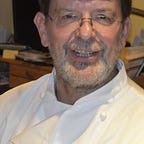Enez Sun
The most decorated French WWII hero (Croix de Guerre, Croix de la Libération and Medaille de la Résistance) awaits your visit!
It’s worth it! I can confirm.
Our trip goes to an island of Brittany, the most northwestern corner of France. Enez Sun is the Breton name for this island. In French: Ile de Sein, one of the westernmost of all French islands. How to get there? From Paris by train (TGV: train of great velocity) to one of the larger cities (Brest, Rennes, Nantes, St.Malo) and then by rental car to a port town served by Penn Ar Bed ferries. I recommend to start at Audierne, from here 60 min sea passage should be enough to reach the island — depending on weather conditions.
Before we arrive: where is the war hero?
It is the whole island! In 1940, General de Gaulle, by radio address from London, asks all French men fit for military service to fight with him against the Nazis. As a result, 144 men leave the island at night on their fishing boats.
When the Nazis arrive on the island, they find only women and children, the priest and the lighthouse keeper. The fishermen are in London. At the French Exile Navy, they make up a quarter of the founding crew, prompting de Gaulle to exclaim admiringly, “This island is a quarter of France!” By the end of the war, 29 men had lost their lives. This is the sad basis of the awards.
The Ile de Sein is small, less than 2km long and between 200m and 800m wide. And as close to sea level as the deck of a sailboat — average height above sea: 1.50m. From the mainland only 6km away, but divided by a cliffy narrowness with fierce sea currents.
We approach from the mainland. The island first appears only as a gray line on the horizon, a thin line, slowly growing denser, slightly contoured, increasingly contrasted against the blue/ often only gray sea. White flashes, reflections — a mirage? But then the image of an elongated, black and white barque — with lighthouses, church tower, gable walls, a few small fishing boats, no tree.
What are we doing there? Quiet, solitude, beauty, purity, nature, sea and fresh wind, that’s the main thing for me (as long as you avoid the European vacation months of July and August), the typical dishes of Brittany in quite a few restaurants, simple accommodation — for who wants to stay.
A day trip should be enough, unless the tranquility tempts you to take a while. Walking around the small island, you might meet some of the still 200 inhabitants — also a few of the people who were with us on the ferry. Visually, this island, like all of Brittany, is hard to capture in one stay.
How was life in former times? So poor that even Louis XIV, the Sun King, refused to tax the islanders. This, he said, was as pointless as imposing taxes on the sea and the storms themselves.
In the background, they say, still murmur the ancient legends, spirits and druids. It is said that from the nearest mainland bay, the Baie des Trépassés, the Bay of the Dead, the Celts would have brought their deceased druids to the Enez Sun to bury them there. This is where the nine oracle witches would have…, well…who knows? Menhirs are still waiting.
Geoffrey of Monmouth, in any case, has already used these descriptions for his “Life of Merlin”. J-L. Bannalec has modern shivers at the ready: his Brittany crime novels are a must for the connoisseur because of the precise and also clue-rich descriptions of Brittany. Volume 5 has the killer murdering on the Ile de Sein. “The case will take … to the unique Île de Sein, the former home of powerful witches …”(© MacMillan Books).
After returning to the mainland, another short trip to the Pointe du Raz, near Audierne, to enjoy the flashing lighthouse signals of the cliff chain hugging the island as a farewell at dusk.
( The author lives on the French-German border and was fortunate enough to learn the languages — which has greatly facilitated my travels through Western Europe over the past fifty years )
